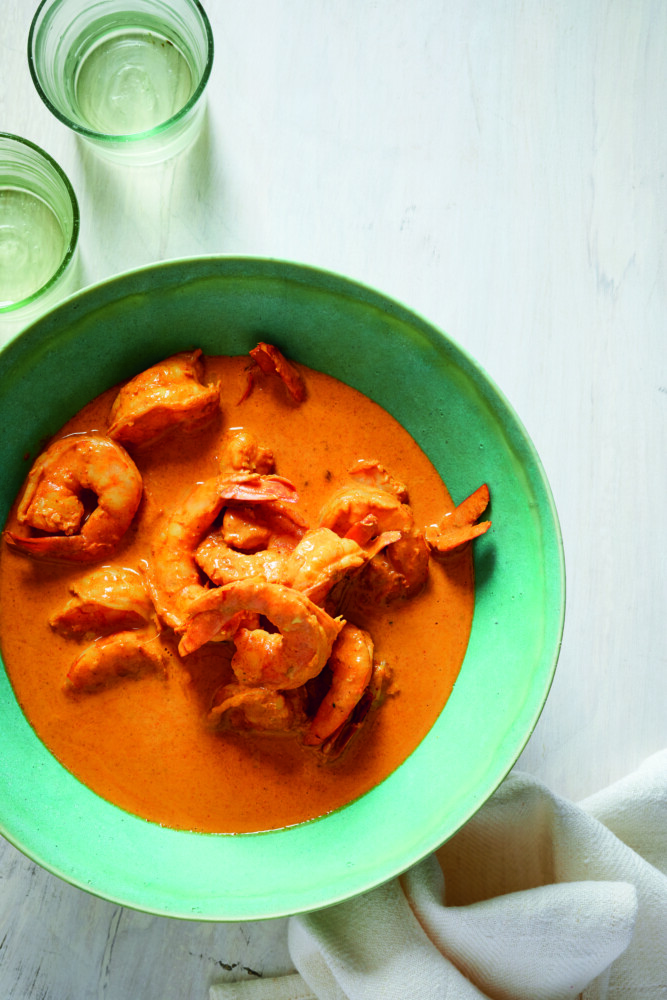My relationship with my best friend Lauren began with the meals we shared in high school: the chocolate souffles we baked instead of going to parties, the huevos rancheros at the Wendy’s-turned-Mexican-restaurant in our hometown, the Italian sandwiches we ate under our beach towels to guard them from seagulls in Ocean City, N.J.
But more than anything, I think about Lauren when I eat Indian food. I remember her confidently ordering my first mango lassi and lamb vindaloo in a strip mall restaurant when we were 16. Over the years since, I have learned more about eating and cooking Indian dishes, on occasion with Lauren across the table or in the kitchen. Just last week, we chatted during a long phone call about shrimp curry she planned to make that night. That conversation must have been in my mind as I flipped through Madhur Jaffrey’s “Instantly Indian Cookbook: Modern and Classic Recipes for the Instant Pot,” or perhaps I was just missing her, but I stopped on the page for Goan Shrimp Curry either way.

Cover courtesy of Alfred A. Knopf
“The idea of traditional Indian food being prepared with the help of a pressure cooker is not new or alien to me or to any Indian,” Jaffrey, whose cookbooks have previously won James Beard awards, writes in her introduction. “For at least the last forty years, almost every middle-class Indian household has one, two, or even three pressure cookers whistling away in their kitchens to let them know that their dried split peas are done or their rice is ready or that their meat is tender.”
Instant Pots were having a moment when I made my wedding registry last year, and I opened mine excitedly when my husband’s very kind aunt gave it to me at my bridal shower. I use it a few times a month, and I found it most helpful over the summer when I didn’t want to turn on the oven. But most of the meals I make involve one button (“Pressure Cook”) and meat that will eventually be shredded (chicken or pork), and I haven’t really experimented with the other functions like the “Steam” or “Saute” settings. So I was attracted to a central premise of Jaffrey’s book, which is that she wants to use the wide range of tools the Instant Pot offers.
“It is a multipurpose cooking utensil that takes some experimentation to master,” she writes.
The cookbook is certainly easier to read than the Instant Pot instruction manual. It is 170 pages with both a detailed table of contents and a thorough index. Some of the recipes are illustrated with photos. All of them indicate the buttons on the Instant Pot with a bold orange font, so the reader can clearly see how simple or complex a recipe might be. The dishes range from simple soups and dals that require little more than sealing the pot and hitting a button, to fish and meal entrees that don’t allow the cook to walk away for long. Some of the basic recipes (Kale cooked in a Kashmiri style or Everyday Chickpeas) struck me as perfect for the experimentation Jaffrey suggests, simple enough to help me gain confidence with a new kitchen tool. But her instructions are clear enough that I feel comfortable attempting some of the more involved recipes, too, like the Kerala Lamb Stew.
The shrimp curry had only two basic steps, so it was perfect for a quick weeknight meal. I used the pressure cooker function for the sauce, and the shrimp itself cooked in the liquid on “Saute.” I found the sauce to be a little watery and added more coconut milk to thicken it. But the end result was the star of a delicious dinner, and I realized that using more Instant Pot functions also means I can use fewer dishes. Because shrimp cooks in minutes, this dish probably would not be much different on the stovetop, but it started to make me think about the Instant Pot in a different way.
I’ll turn to this cookbook when I want an Instant Pot adaptation of an old favorite like Butter Chicken, or when I want to try something new like Lamb Mulligatawny Soup, or when I am just feeling nostalgic for those teenage days in a strip mall restaurant with my best friend.
GOAN SHRIMP CURRY
The author’s note: “This is the hot ‘prawn curry,’ as it is called here, found on the beaches of Goa. It is very simple to prepare, and is delicious eaten with rice. Normally, several teaspoons of a very red but milder chili powder would be used here. I have suggested less and used paprika to add to the color.”
1/2-1 teaspoon chili powder
1 tablespoon bright red paprika
1/2 teaspoon ground turmeric
4 cloves garlic, peeled and crushed to a pulp
2 teaspoons peeled fresh ginger, grated to a pulp
2 tablespoons ground coriander
1 teaspoon ground cumin
3/4 teaspoon salt, or to taste
2 teaspoons tamarind paste, or to taste (use lemon juice to taste as a substitute)
1 pound medium shrimp, peeled and deveined
1 cup coconut milk from a well-stirred can
Put the chili powder, paprika, turmeric, garlic, ginger, coriander and cumin in a bowl. Slowly add 1 1/4 cups water, mixing as you go. Pour this mixture into the inner pot of your Instant Pot. Close and seal the lid. Cook at LOW PRESSURE for five minutes and let the pressure drop by itself for 10 minutes. Release the remaining pressure manually. Open the lid, venting the remaining steam away from you.
Add the salt and tamarind or lemon juice to the sauce, balancing the flavors to your taste. The sauce will seem a bit rough at this stage. Select the SAUTE setting set to Normal. Add the shrimp and the coconut milk. Stir gently and cook until all the shrimp have turned opaque. Taste the sauce again for balance of flavors.
Send questions/comments to the editors.


